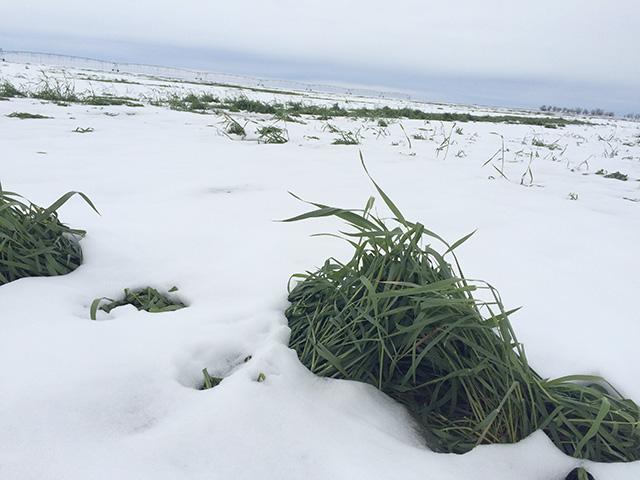Freezing Temps Threaten Winter Wheat
Spring Freeze Threatens Winter Wheat in Reproductive Phase
ANKENY, Iowa (DTN) -- During several decades of farming, Kent Winter has endured countless nights wondering if a spring freeze will damage his winter wheat. It never gets easier.
"I'm nervous about this," the Mount Hope, Kansas, farmer said Tuesday afternoon.
He said overnight temperatures are forecast to dip to 27 degrees Fahrenheit. With most of his 750 acres of hard red winter wheat in the joint stage and approaching the boot stage, he's concerned the frigid temps could damage plants and reduce yields. Freeze damage early Wednesday to winter wheat is a concern throughout the central and southern Great Plains where the bulk of the crop is grown, according to the DTN weather team. Here's more on that story: www.mydtn.com/agriculture/web/ag/news/blogs/blog-post/2021/04/20/damaging-freezes-plains-midwest.
Freezing temperatures do not guarantee winter wheat damage. Winter just hopes there isn't a repeat of the Easter freeze of 2007, when temperatures got down to 22 degrees Fahrenheit and decimated his winter wheat that was in the joint stage at that time.
"We got smoked. The crop was nearly wiped out," Winter recalled. "We harvested a lot of 3- to 5-bushel-per-acre wheat that year.
"But then there's been plenty of other times that troubling temperatures occurred and we came out OK," he continued. "I've ridden this roller coaster before. It will be a week to 10 days before we know if there's any damage."
DTN Senior Ag Meteorologist Bryce Anderson said forecast temperatures in the upper to lower 20s for most of Kansas, Oklahoma and the Texas Panhandle early Wednesday morning could jeopardize winter wheat. More than half of the 33.1 million acres planted in the U.S. are in those three states, according to USDA. Kansas has the largest acreage at 7.3 million acres.
P[L1] D[0x0] M[300x250] OOP[F] ADUNIT[] T[]
Winter wheat can withstand freezing temperatures while dormant. As the crop moves into the reproductive phase, that's no longer the case.
"It sure seems to be there's potential for some damage," Anderson said referring to the recent cold snap. "Cold weather hardiness is over for this year's crop."
According to Kansas State University (KSU), the following yield loss and damage could occur to winter wheat in various development stages due to freezing temperatures:
-- Moderate to severe yield loss can occur when temperatures hit 24 degrees Fahrenheit or colder for 2 hours or more during the joint stage. Damage includes death of growing point, leaf yellowing or burning, lesions, splitting, bending of lower stem and odor.
-- Moderate to severe yield loss can occur when temperatures hit 28 degrees Fahrenheit or colder for 2 hours or more in the boot stage. Damage includes floret sterility, spike tramped in boot, lower stem issues, leaf discoloration and odor.
-- Severe yield loss can occur at temperatures of 30 degrees Fahrenheit or colder for 2 hours or more in the heading stage. Damage includes floret sterility, lower stem issues, and leaf discoloration.
"Wheat development makes a big difference when it comes to handling cold temperatures," said Stewart Duncan, a KSU Extension agronomist. "Freeze damage also depends on plant health. If the crop isn't too stressed, that will help."
Fifty-five percent of Kansas winter wheat acres are rated in good-to-excellent condition as of Sunday, according to USDA. Half of the crop has reached the joint stage.
USDA reports 69% of Oklahoma's 4.3 million acres of winter wheat are in good-to-excellent condition as of Sunday. Eighty-six percent of the crop is in the jointed stage and 17% is headed.
Texas has 5.5 million acres of winter wheat, according to USDA data. The crop is rated 28% in good-to-excellent condition with 41% of plants headed.
Subzero temperatures in February created concern for winter wheat farmers. Read about that here: www.dtnpf.com/agriculture/web/ag/crops/article/2021/02/24/winterkill-wheat-jury-still-historic.
A freeze threatened winter wheat last April as well. Read about it here: www.dtnpf.com/agriculture/web/ag/blogs/ag-weather-forum/blog-post/2020/04/15/multiple-freezes-threaten-winter.
Matthew Wilde can be reached at matt.wilde@dtn.com
Follow him on Twitter @progressivwilde
(c) Copyright 2021 DTN, LLC. All rights reserved.






